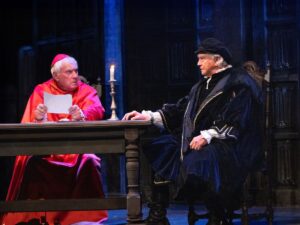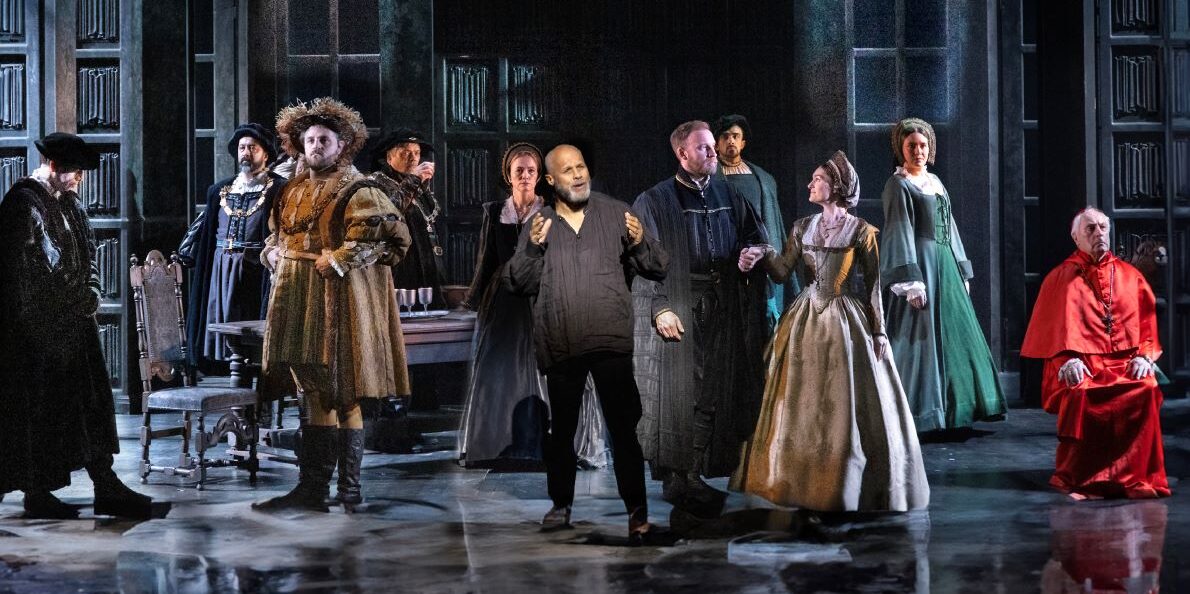A Man for All Seasons follows Sir Thomas More who, rising to the heights of Lord Chancellor in the first half of the play, ends up on an executioner’s chopping block, due to his refusal to recognise Anne Boleyn’s children as the rightful heirs to the throne. This story will hardly be unfamiliar to a British audience. From film to literature, Henry VIII’s separation of the Church of England from the Roman Catholic Church has been covered countless times. What is interesting about Robert Bolt’s play is his rather unique angle of approach to such a well-worn story.
A Man for All Seasons is above all a play about principles and performance – its focus is on one man’s refusal to compromise on his ideals, on his refusal to perform in a society that bases itself on performative exchanges. Sir Thomas More is executed not because of anything he says or does, but crucially because of what he refuses to say and do. Sir Thomas More is executed because he refuses to make his private opinions public.
The prologue is very cleverly directed by Jonathan Church as an introduction to the play’s themes. Characters enter the stage in an almost zombie-like fashion, their brightly coloured costumes striking against the darkness of the stage as they pose frozen. This non-naturalistic entry into the world of the play makes it hard not to see the rest of the performance in the light of “all the world’s a stage”.
Out of this tableau emerges the Common Man. Just like his comically vague name, he is dressed in the most chameleonic garb. The Common Man, in stark contrast to all the other characters, wears very plain, black clothes. Throughout the play, he changes costume on stage as he assumes the person of all the common men who make the world of courtly intrigue go round. He is brilliantly played by Gary Wilmot, who is the perfect blend of an indifference which, while largely comedic, often veers into the depressing. The Common Man, as he often reminds us, is not in a financial or social position to be moral – for him performance has nothing to do with ambition but with survival.

Thomas More’s home is at all hours entered and occupied by often unwanted visitors. Courtrooms, courtyards, offices and drawing rooms are all stages within the stage, sites of performance for this play’s characters. This interchangeability between public and private spheres is brought out by Simon Higlett’s both practical and intelligent set design. The base set is always the same – every indoor location looks basically identical, with changes in lighting signalling movement from one house to the next. Equally, when an outdoor setting is required, on-stage doors part to create open space or clever lighting tricks are used to suggest widely different locations. Importantly, however, this mutability of the set highlights the encroachment of public spaces into the private and helps to convey the idea of an almost unattainable privacy. This is a feeling that reaches its climax at the end of the play, when More – standing in a jail which looks virtually identical to his home – is accused of treason for what goes on inside his head.
The main issue with Church’s take on A Man for All Seasons is that it is, at times, too traditional. While the acting is of a high standard – Martin Shaw being particularly compelling as More – the play’s not insubstantial runtime does not always feel entirely justifiable. There are multiple moments, such as More’s trial and execution, where one is simply left with the feeling that more could have been done.
Drama
A Man For All Seasons
By Robert Bolt
Directed by Jonathan Church
Cast Includes: Martin Shaw; Gary Wilmot; Calum Finlay; Edward Bennet; Abigail Cruttenden
Until Saturday 22nd February 2025
Running Time: 2h 35mins with an interval
Photo Credits: Simon Annand

